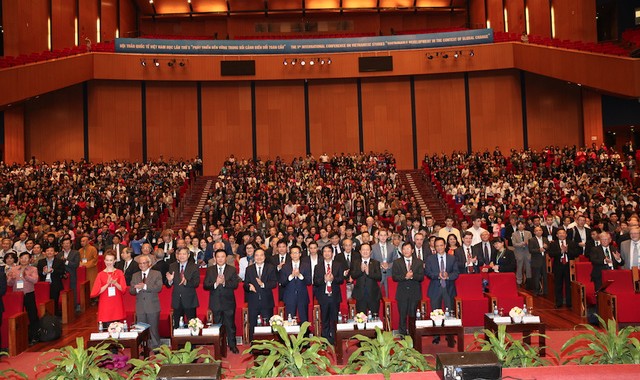Hội thảo quốc tế Việt Nam học đã diễn ra trong 2 ngày 15 – 16/12, thu hút được sự quan tâm đăng ký và gửi tóm tắt báo cáo của hơn 1.200 nhà khoa học, trong đó có 150 nhà khoa học nước ngoài đến từ trên 30 quốc gia và vùng lãnh thổ.
834 bản báo cáo tóm tắt và gần 500 báo cáo toàn văn đã được lựa chọn trình bày tại hội thảo, trong đó có 30 báo cáo được mời và đặt hàng từ các học giả có uy tín và tầm ảnh hưởng hàng đầu trên thế giới về ngoại giao, văn hóa, kinh tế, giáo dục, đổi mới sáng tạo và biến đổi khí hậu.
Nhóm nghiên cứu của GS Nguyễn Đình Đức (ĐHQGHN) và GS Hiroyuki Kusaka (ĐH Tsukuba) đã có báo cáo khoa học chung tham gia báo cáo tại Tiểu ban 6 về Biến đổi khí hậu của Hội nghị này:
APPLYING DYNAMICAL DOWNSCALING METHOD WITH A HIGH-RESOLUTION REGIONAL CLIMATE MODEL FOR LOCAL CLIMATE PROJECTION OF GREATER HANOI CITY
Đoàn Quang Văn1*, Hiroyuki Kusaka1
Nguyễn Minh Trường2
Đoàn Hồng Đức3, Nguyễn Đình Đức3
1 University of Tsukuba, Japan
2 Hanoi University of Science, Vietnam
3 University of Engineering and Technology, Vietnam
* Corresponding author, email address: doan.van.gb@u.tsukuba.ac.jp
Keywords: Global warming; future urban climate; dynamical downscaling; Hanoi.
Paper’s ID: VS6.028.P hd film izle
Abstract
This is well known that the urbanization can increase the urban heat island effect and modify the localized rainfall system, especially in cities where urbanization is fast proceeding. For the Greater Hanoi city, the problem could be more complicated when the city will face both effects global warming and future urbanization. This study attempts to project the local climate of the Greater Hanoi city in considering the impacts of global warming and the local urban expansion by using the dynamical downscaling (DDS) method. In fact, there were some previous studies using DDS to project the climate of Vietnam in general; however, at a low spatial resolution, these studies cannot capture the localized meteorological events such as urban heat island (UHI) or urbanization-related heavy rainfall. In this study, DDS is applied with 2-km horizontal-resolution regional climate model (RCM) coupled with urban canopy model (UCM) to simulate and project the UHI phenomena as well as the localized heavy rainfall over the city. The outputs from three global climate models (GCM) for two global warming scenarios Representative Concentration Pathways 4.5 and 8.5 are used to create the initial and boundary condition for RCM. The future urban expansion, according to the master plan of Hanoi City is included in the model, so that the DDS results can reflect the impact of local urbanization on urban climate. The performance of the model is evaluated by comparing the simulated results for climatological variables such as air temperature, humidity and rainfall versus those of observation. The projected results are analyzed and the impact of future urbanization and global warming on the change in localized UHI and heavy rainfall are quantified.

